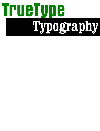
N.B. An asterisk before a word means it has its own entry in the glossary.
- 'gasp' table
-
The optional TrueType table that holds information about font smoothing (also known as *grey-scale or *anti-aliasing). The type designer can specify here how hinting and font smoothing should work together. See Microsoft's spec for the format in detail. Currently this table is not supported on Apple platforms, notwithstanding Microsoft's unfortunate use of lower-case letters... (Apple reserved the right to these.)
- GetGlyphOutline
-
The Windows GDI function to retrieve the *outline points from a *glyph in a TrueType font. The function fails for any font other than TrueType, although OpenType-compatible versions of Windows (e.g. NT 5.0) can retrieve Type 1 outlines.
- 'glyf' table
-
The part of a TrueType font file where *glyph outlines and *hints are stored. See Apple's spec or Microsoft's spec for the format in detail.
- glyph
-
An image for a *character in a particular font and style. TrueType draws the distinction between (displayed) glyphs and (semantic) *characters. Characters are merely codes, remaining constant irrespective of font or style. The character map table *'cmap' maps characters indices onto the glyphs stored sequentially in the *'glyf' table.
A TrueType glyph may be simple (made up of *outlines plus *instructions) or *composite (made up of other glyphs plus instructions). - glyph program
-
The TrueType *instructions associated with a particular *glyph. When that glyph needs to be rasterized, its *outline is scaled according to the current point size and the device, then the glyph program is executed to produce the distorted (*grid-fitted) outline that is finally filled by the *scan-converter. The *bitmap is finally ready to be displayed.
- graphics state
-
An internal data structure maintained by TrueType, containing values that affect the behaviour of numerous TrueType *instructions. Values in the graphics state can themselves be changed by instructions. See Apple's Graphics State description.
- grey-scale fonts
-
Rather than just using black or white pixels, display systems can improve appearance of fonts (and other graphics) by judicious use of grey pixels of various shades - as well as black and white. An edge pixel will become light or dark grey, depending on how much black you'd find if you zoomed in on that pixel. The effect is of a higher resolution, improving aesthetics and, if done with skill, legibility. It's another term for *anti-aliasing.
- grid
-
The pixels of an output device can be regarded as the squares of a grid. The action of the TrueType *scan-converter can be seen as placing this grid over the scaled and *grid-fitted *outline, then turning squares white or black depending on whether their centres are inside or outside the outline.
- grid-fitting
-
A metaphor for what *hinting actually does. Grid-fitting is the process of adjusting control points with respect to the *grid, so that the glyph, when *scan-converted, is legible and aesthetically pleasing. Unless you're doing unusual things with hinting, it is true to say that hinting is the process of obtaining a grid-fitted outline from an original *glyph *outline in a scalable font. In TrueType, all grid-fitting is programmed with *instructions.
- 'gvar' table
-
The table describing how the *glyph designs vary in *GX *variations fonts. The idea is to specify maximum offsets from a central description, rather than the extreme axial positions found in *multiple master fonts. See Apple's spec for the format in detail.
- GX Typography
-
GX Typography, part of QuickDraw GX, was Apple's great leap forward in font technology. GX fonts, which can be TrueType or Type 1, contain a variety of "intelligent" behaviour, from smart ligature substitution to *variations technology (very similar to *multiple masters). See the GX page at this site. GX Typography is now part of *AAT.
- GXifier
-
This was a program (free from Apple) necessary to convert Type 1 fonts for use with Apple's GX system. It would create tables within the font, after detecting features like ligatures, or *multiple masters. TrueType fonts with ligatures could be GXified too.
In Apple's latest operating systems, with *AAT, you no longer have to "GXify" fonts to access their typographic richness. (They realized that having to convert your fonts was a disincentive to using GX.)
TYPE*chimérique | TrueType Typography | TYPE*links